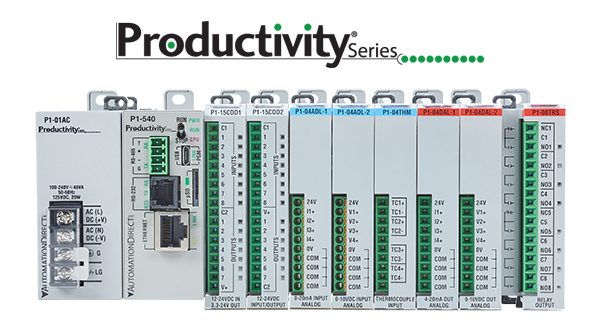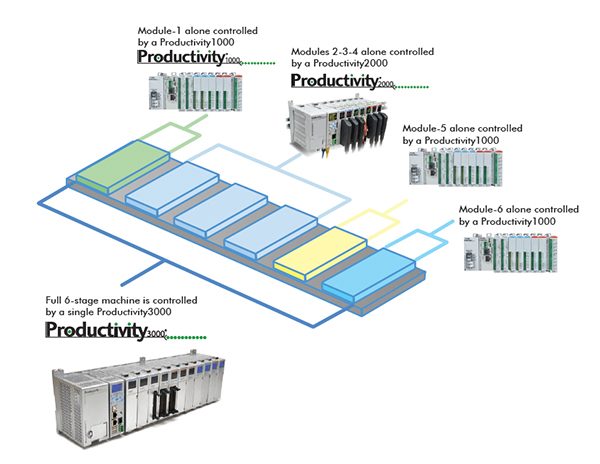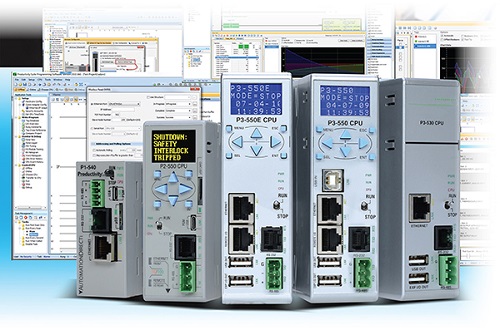 With the release of the Productivity1000, the newest and smallest of the Productivity Series controllers, we now have a scalable product offering that gives you the flexibility to design
With the release of the Productivity1000, the newest and smallest of the Productivity Series controllers, we now have a scalable product offering that gives you the flexibility to design
your control system program for a broad range of applications and sizes, without sacrificing functionality.
The Productivity1000 (P1000) is a compact, stackable micro Programmable Logic Controller (PLC). While it may be small in stature, it has a big heart. How big you may ask? 50MB to be exact. That’s the amount of memory included in the $169 P1-540 CPU, the heart of the control system.
The new P1000 PLC complements an already existing and mature platform of programmable controllers that includes the Productivity3000 (P3000) and Productivity2000 (P2000). This series of controllers has many common features that can benefit their users. This includes but is not limited to:
EtherNet/IP & Modbus TCP protocols standard
- Tag name base programming
- Tremendous communication capabilities
- Integrated data logging removable media (USB or uSD)
- Large memory capacity for program and user memory
- And many more
However, a key benefit of the Productivity Series is the scalability of the control program. The Productivity Series now has three controller platforms (P3000, P2000, P1000), each with their own unique hardware features, but very similar in programming and functionality. These systems were designed so you can write a program in one controller and easily port to another. By using the Project Conversion utility within the software’s hardware configuration, you can convert from any P-series hardware platform to another and retain the same program.
Why is scalability important to so many?
For many Original Equipment Manufacturers (OEMs), System integrators (SIs) and some end users, having a PLC family that can use a single or similar program and be ported across various platforms for different machine configurations is an incredible time saver.
 Some machines may be advertised as a complete solution that includes multiple functional modules:
Some machines may be advertised as a complete solution that includes multiple functional modules:
- Product preparation
- Process stage1
- Process stage2
- Process stage3
- Inspection phase
- Packaging
- Etc.
However, some customers may be integrating into an existing production environment that already contains elements of the full solution, or perhaps they simply do not require initial prep for the product, inspection or packaging. It’s possible they’re only interested in the main three modules of the process.
Depending on the application, this may drastically change the look, size, functionality and specifications required by the customer. In the example below, the full 6-stage process program was designed with the Productivity3000 hardware to accommodate the I/O requirements for the entire system.
So if a customer only requests the core of the system (modules 2-3-4), the P3000 is now likely overkill and would be costly to continue to use. In this case, the OEM or SI can simply substitute the P2000 hardware and convert the project. In minutes the original program can be converted and the unnecessary tasks can be moved to the Disable Task folder or deleted from the program completely.
 Similarly, if a customer is looking to add just an inspection module to an already existing application, they may determine the P1000 is powerful enough to handle the processing requirements and can accommodate the minimal I/O needed for this particular stage. Same process … Begin with the original program, convert the project and remove the unnecessary tasks.
Similarly, if a customer is looking to add just an inspection module to an already existing application, they may determine the P1000 is powerful enough to handle the processing requirements and can accommodate the minimal I/O needed for this particular stage. Same process … Begin with the original program, convert the project and remove the unnecessary tasks.
Consider a machine that is configured around a PLC line without a scalable offering. Now the OEM or SI could be forced to select a completely different PLC line for smaller or larger variations of the same application. This is time consuming and costly for the programmer as well as the end user, who is now forced to support multiple varieties of controllers that do not use a common programming environment.
On the other hand, the scalability offered by the Productivity Series of controllers ensures the right amount of control for each particular application.
To read more articles from Automation Notebook, click here.
*Originally published: April 17, 2018

